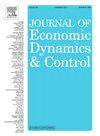青年工人的生活安排和劳动力市场波动性
IF 2.3
3区 经济学
Q2 ECONOMICS
引用次数: 0
摘要
家庭规模是反周期的,主要是因为年轻人搬进或推迟离开父母的家。与独居的同龄人相比,生活在年长家庭中的人收入更低,工时更不稳定。我们提出了商业周期中家庭形成和劳动力选择的理论。年轻人根据自己的工资、在老家庭生活的喜好以及获得的隐性转移支付来决定在哪里生活。我们的理论解释了家庭规模波动对总工时波动的大部分贡献。将不同生活安排的人包括在内,隐含的总体或宏观弗里希弹性比假定的微观弹性大 70%左右。本文章由计算机程序翻译,如有差异,请以英文原文为准。
Living arrangements and labor market volatility of young workers
Household size is countercyclical, mainly because of young people moving into or delaying departure from the parental home. Those living in older households earn less and have more volatile hours than their peers living alone. We pose a theory of household formation and labor choice over the business cycle. Young people decide where to live depending on their wage, taste for living within the old household, and implicit transfers received. Our theory accounts for the bulk of the contribution of the household's size volatility to the volatility of the aggregate hours. Including people with varying living arrangements yields an implied aggregate, or macro, Frisch elasticity around 70 percent larger than the assumed micro elasticity.
求助全文
通过发布文献求助,成功后即可免费获取论文全文。
去求助
来源期刊

Journal of Economic Dynamics & Control
ECONOMICS-
CiteScore
3.10
自引率
10.50%
发文量
199
期刊介绍:
The journal provides an outlet for publication of research concerning all theoretical and empirical aspects of economic dynamics and control as well as the development and use of computational methods in economics and finance. Contributions regarding computational methods may include, but are not restricted to, artificial intelligence, databases, decision support systems, genetic algorithms, modelling languages, neural networks, numerical algorithms for optimization, control and equilibria, parallel computing and qualitative reasoning.
 求助内容:
求助内容: 应助结果提醒方式:
应助结果提醒方式:


